
An equestrian statue is a statue of a rider mounted on a horse, from the Latin "eques", meaning "knight", deriving from "equus", meaning "horse". A statue of a riderless horse is strictly an equine statue. A full-sized equestrian statue is a difficult and expensive object for any culture to produce, and figures have typically been portraits of rulers or, in the Renaissance and more recently, military commanders.
Robert Graham was a Mexican-born American sculptor based in the state of California in the United States. His monumental bronzes commemorate the human figure, and are featured in public places across America.

The Nelson Monument is a monument to Admiral Horatio Nelson, in Exchange Flags, Liverpool, England. It was designed by Matthew Cotes Wyatt and sculpted by Richard Westmacott. It stands to the north of the Town Hall and was unveiled in 1813.

Pobednik is a monument in the Upper Town of the Belgrade Fortress, built to commemorate Serbia's victory over Ottoman and Austro-Hungarian Empire during the Balkan Wars and the First World War. Cast in 1913, erected in 1928, and standing at 14 metres (46 ft) high, it is one of the most famous works of Ivan Meštrović. It is also one of the most visited tourist attractions in Belgrade and the city's most recognizable landmark.

The Place des Quinconces, located in Bordeaux, France, is the largest city square in Europe.

The Franklin D. Murphy Sculpture Garden is one of the most comprehensive sculpture gardens in the United States. The garden is located on the campus of the University of California, Los Angeles and is run by the Hammer Museum.

Torso Fragment, a public sculpture by the American artist Casey Eskridge, is located on the Indiana University–Purdue University Indianapolis (IUPUI) campus, near downtown Indianapolis, Indiana. The piece was donated to IUPUI and is located outside of the west entrance to Eskenazi Hall on the IUPUI campus. Eskenazi Hall houses Indiana University’s Herron School of Art and Design and is located at 735 W. New York Street in Indianapolis. The sculpture was created in 2005.
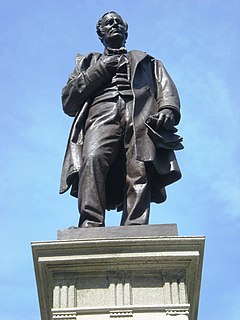
The Thomas A. Hendricks Monument is a public artwork by American artist Richard Henry Park and is located on the southeast corner of the Indiana Statehouse grounds in Indianapolis, Indiana. The monument is a tribute to Thomas A. Hendricks, the 21st Vice President of the United States. Hendricks was a former U.S. Representative and U.S. Senator from Indiana. He was the 16th Governor of Indiana and led the campaign to build the Indiana Statehouse.

Spirit of Commerce is a public artwork by German artist Gustav Haug located in Jackson Park, which is on the south side of Milwaukee, Wisconsin. This zinc sculpture is 15 feet tall and sits on a red granite pedestal near the park's lagoon. It is the oldest public sculpture in Milwaukee.
Calvin Fletcher is a public artwork by an unknown artist, located inside the Indiana Statehouse in Indianapolis, Indiana, United States. The marble bust depicts Calvin Fletcher (1798–1866), a man who settled in Indiana early in the state's history and went on to become an attorney and senator. The bust stands 47.5 inches high, has a width of 20 inches and a depth of 10.25 inches.
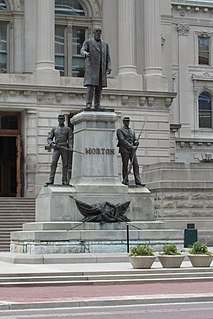
Oliver P. Morton and Reliefs is a public artwork by Austrian artist Rudolph Schwarz, located on the east side of the Indiana Statehouse in Indianapolis, Indiana, at the intersection of North Capitol Avenue and West Market Street.
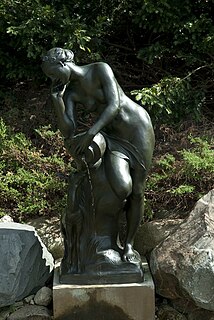
Nymph and Fawn is a public artwork by American artist Isidore Konti and located within the Oldfields–Lilly House & Gardens estate on the grounds of the Indianapolis Museum of Art (IMA), near Indianapolis, Indiana. Created in 1917, the bronze sculpture is also a working fountain. It portrays a female nude pouring water from an urn while standing beside a small fawn.
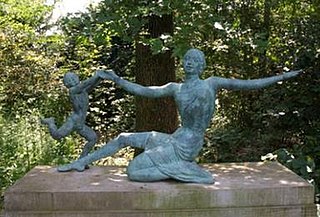
Mother and Child is a public artwork by the Russian-British artist Dora Gordine, located at the Indianapolis Museum of Art (IMA), which is near downtown Indianapolis, Indiana. The cast bronze artwork was created in 1964 and portrays a woman kneeling beside a small child, both figures displaying joyful poses and expressions.
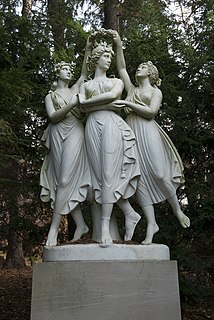
The Three Graces is a nearly life-size, figurative Carrara marble outdoor sculpture group located on the historic Oldfields estate on the campus of the Indianapolis Museum of Art (IMA), in Indianapolis, Indiana. The neoclassical marble sculpture depicts the Three Graces, minor goddesses of the Greco-Roman pantheon. The group consists of three women frontally oriented, standing in a row upon a base. The sculpture is modeled after a c. 1797 sculpture by Antonio Canova.

Female Herm and Male Herm are a set of two neoclassical marble herms in the outdoor sculpture collection of the historic Oldfields estate, located on the campus of the Indianapolis Museum of Art (IMA), in Indianapolis, Indiana. Together the herms depict either Dionysus and a Maenad or a dryad and a satyr.

The Admission Day Monument is an 1897 sculpture by Douglas Tilden, located at the intersection of Market Street and Montgomery Street in San Francisco, California, United States. It commemorates California Admission Day, the date on which the state became part of the Union, following the Mexican-American war of 1848.

The Quest, sometimes referred to as Saturday Night at the Y or Three Groins in a Fountain, is an outdoor marble sculpture and fountain designed by Count Alexander von Svoboda, located in Portland, Oregon in the United States. The sculpture, carved in Italy from a single 200-ton block of white Pentelic marble quarried in Greece, was commissioned by Georgia-Pacific in 1967 and installed in front of the Standard Insurance Center in 1970. It depicts five nude figures, including three females, one male and one child. According to the artist, the subjects represent man's eternal search for brotherhood and enlightenment.

The Chiming Fountain, also known as Cupid's Fountain, the John Staehli Fountain, Portland's City Park Fountain and Washington Park Fountain, is an outdoor cast iron fountain and sculpture built in 1891 by John "Hans" Staehli. It is installed in Washington Park in Portland, Oregon, United States. The fountain's name derives from the sound made when water drips from the upper basin. Staehli designed the fountain to serve as a watering trough for horses pulling carriages into the park. Based on a Renaissance fountain, it was originally painted white and included a statuette of a boy, possibly depicting Cupid, though the figure was damaged and permanently removed from the sculpture before or during the 1940s.

Civic Virtue Triumphant Over Unrighteousness (1909–1922) is a sculpture group and fountain in New York City, created by sculptor Frederick William MacMonnies and architect Thomas Hastings, and carved by the Piccirilli Brothers. The fountain was originally placed in front of New York City Hall in Manhattan, spent almost 72 years beside Queens Borough Hall in Queens, and the sculpture group is now located in Green-Wood Cemetery in Brooklyn.

Public art in Barcelona is a designated group of monuments and outdoor sculptures in the city. In addition to the architecture and a network of museums, parks, and gardens, the works put an artistic stamp on the Catalan capital. Public art in the city developed in the 19th century, although the first municipal commission was the 1673 monument to Saint Eulalia in Pedró Square.


















